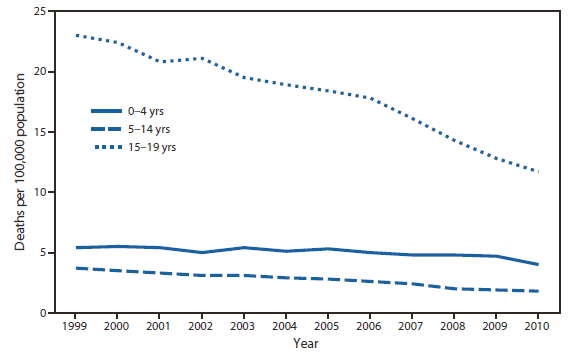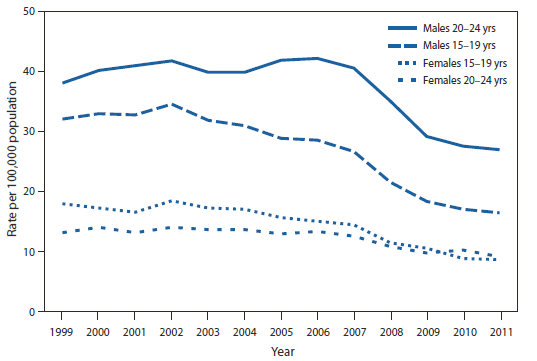This week’s Morbidity and Mortality Weekly Report (MMWR)[1] highlighted new mortality rates for children due to Traumatic Brain Injury (TBI), as shown in the figure below.
The figure shows age-specific mortality rates for three age groups: 0-4 years, 5-14 years, and 15-19 years. Mortality rates declined dramatically for the 15-19 year old group over the 12 years studied. Starting at approximately 23 deaths per 100,000 person-years in 1999, the mortality rate declined by an average by 1 death per 100,000 person-years each year, reaching 12 deaths per 100,000 person-years in 2010.
The rates for the 15-19 year-olds coincides well with a recent report of declining traffic fatalities in that age group, where the mortality rate went from approximately 40 per 100,000 person-years to about 20 per 100,000 person-years from 1999 to 2010, also a 50% drop. 
Further research would be required to determine how much of the decline in TBI mortality rates for 15-19 year-olds can be attributed to the corresponding decline in traffic fatalities, though we suspect the contribution must be significant. As to why traffic fatalities have declined, one reason is certainly the widespread implementation of Graduated Driver Licensing (GDL), wherein various restrictions are placed on teenage drivers.[2-7] The restrictions initially varied considerably, but as research emerged regarding the effectiveness of different programs, certain features have become almost universal, including restrictions on teenager drivers carrying teenage passengers. In 1999, seventeen states had some form of GDL in place for teenage drivers,[6] and by 2010 the policy was being used in all fifty states and the District of Columbia.[7] Research on effective ways to reduce traffic fatalities for teenagers and others is ongoing, of course. It is a complex issue, as a balance must be struck between personal freedom and economic realities on the one hand, and public safety on the other.
References:
- Centers for Disease Control and Prevention. Morbidity and mortality weekly report. March 22, 2013 / 62(11);215.
- Masten SV, Foss RD, Marshall SW. Graduated driver licensing and fatal crashes involving 16- to 19-year-old drivers. JAMA. 2011 Sep 14;306(10):1098-103. doi: 10.1001/jama.2011.1277.
- Chen LH, Baker SP, Li G. Graduated driver licensing programs and fatal crashes of 16-year-old drivers: a national evaluation. Pediatrics. 2006 Jul;118(1):56-62.
- Hartling L, Wiebe N, Russell K, Petruk J, Spinola C, Klassen TP. Graduated driver licensing for reducing motor vehicle crashes among young drivers. Cochrane Database Syst Rev. 2004;(2):CD003300. Review. Update in: Cochrane Database Syst Rev. 2011;(10):CD003300.
- Russell KF, Vandermeer B, Hartling L. Graduated driver licensing for reducing motor vehicle crashes among young drivers. Cochrane Database Syst Rev. 2011 Oct 5;(10):CD003300. doi: 10.1002/14651858.CD003300.pub3.
- Shope JT, Molnar LJ. Graduated driver licensing in the United States: evaluation results from the early programs. J Safety Res. 2003 Jan;34(1):63-9.
- Thor CP, Gabler HC. Assessing the residual teen crash risk factors after graduated drivers license implementation. Ann Adv Automot Med. 2010;54:295-308.
